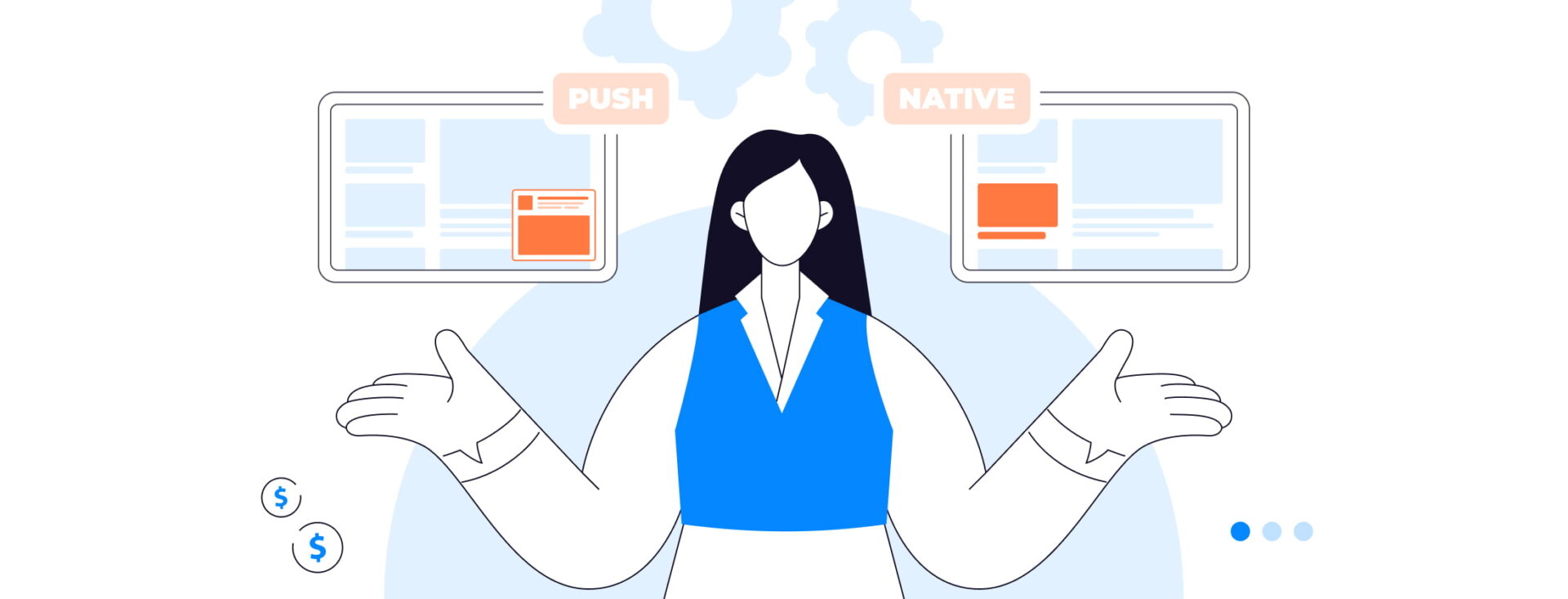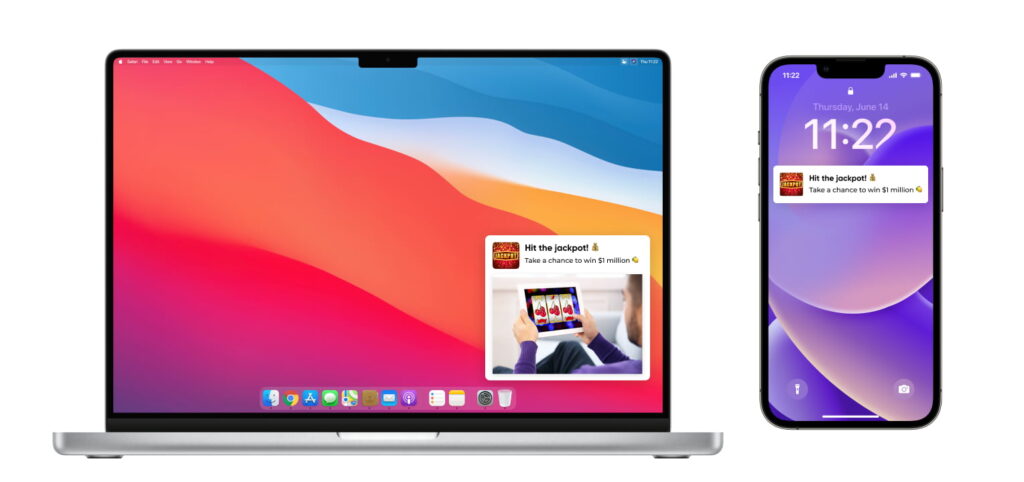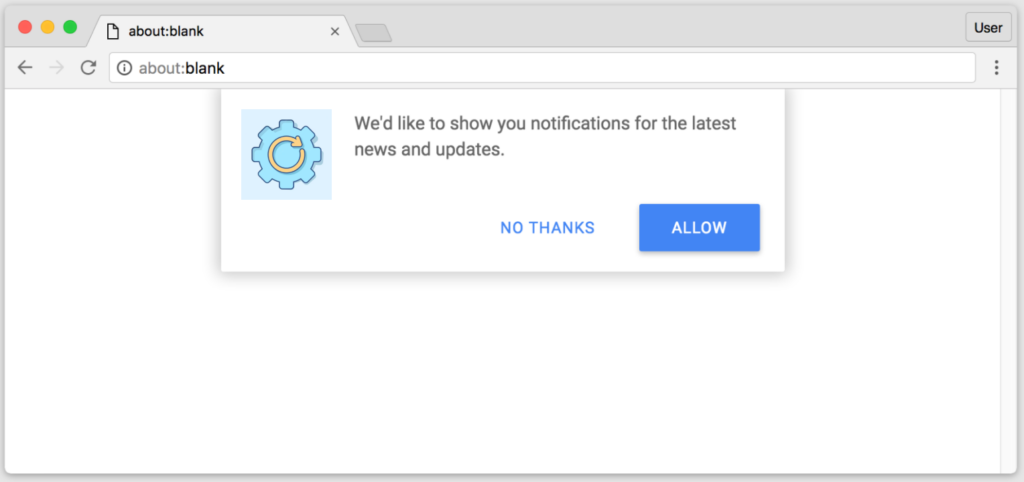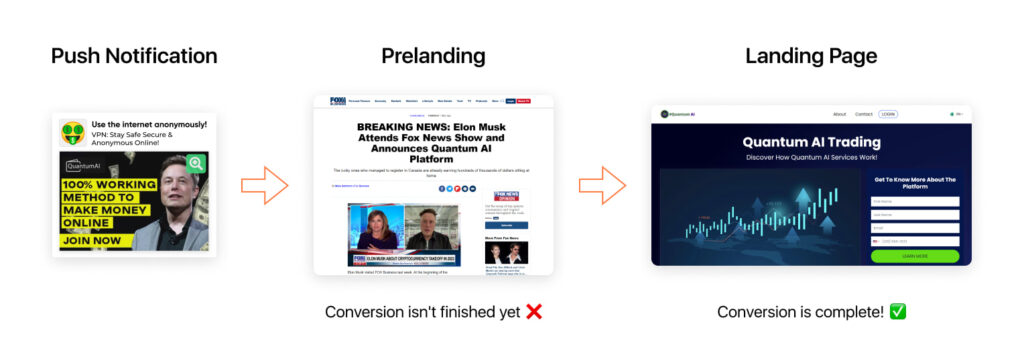Blog

Marketers often grapple with the decision of which ad format to use in order to achieve optimal engagement and conversion rates. Push notifications and native ads are both influential tools, yet they serve very distinct purposes and operate through different mechanisms. While push notifications are designed to capture immediate attention with timely messages, native ads aim to subtly blend in with the user’s content experience for deeper engagement.
Here’s a deeper look into what each format entails, their pros and cons, and how they compare on various criteria. So, if you mull over what to choose – push ads or native ads – keep reading.
Push notifications ads are a powerful tool for advertisers in affiliate marketing, used to deliver messages directly to a user’s device, typically a smartphone or desktop. This direct form of communication is especially effective for engaging users by providing timely and relevant information, regardless of whether they are actively using your app or browsing your website at the moment.

Here’s a detailed look at how push notifications work and why they are valuable in online advertising campaigns.
How do push notifications work, in detail:
1. Opt-in requirement
Before a user can start receiving push notifications, they must first opt in. This happens when a user installs an app and agrees to receive notifications, or when a browser prompts the user to allow notifications from a website. This opt-in model is crucial as it ensures that the communication is consensual, which is important for user experience.

2. Message creation and customization
Once the user opts in, notifications are sent. These messages need to be concise and compelling due to space limitations. To make push notifications, affiliate marketers often use personalization techniques, such as including the user’s name or tailoring messages based on GEO, to increase relevance and engagement.
Here are some common mistakes to avoid when creating push notifications:
3. Triggering notifications
Push advertising can be triggered based on a variety of criteria:
4. Delivery and interaction
Once triggered, the notification is sent to the user’s device via the Internet. It appears on the user’s screen even if the device is locked or the user is engaged in a different app. The user can then interact with the notification, typically by swiping on it, which will direct them to a pre-landing or a landing page.

5. Analytics and optimization
The effectiveness of push notifications is measurable through analytics tools that track how many users open the notifications and what actions they take as a result. Marketers use this data to refine their messaging, targeting, and timing to optimize engagement and conversion rates. Optimization tools include Whitelists/Blacklists, Automated Rules, Microbidding, Target CPA, and Custom Bids. It’s common for push advertising networks to offer many similar tools.
Push notifications have the following pros and cons:
Native ads, in contrast, are advertisements that are seamlessly integrated into the content of a website, mimicking the look and feel of organic content. This integration helps them engage users without disrupting their content experience.

How do native ads work:
1. Integration with content. Native ads are meticulously designed to appear as part of the original content on a platform, whether it’s a social media feed or a news website. This could mean mimicking the visual design, the writing style, or even the behavior of standard content elements on the platform;
2. Focus on user experience. By aligning with the host site’s content, native ads offer a less disruptive and more cohesive browsing experience. The idea is for these ads to be perceived not as interruptions, but as natural, integral parts of the user’s content consumption journey;
3. Content relevance. These ads are typically highly relevant to the content or the interests of the viewers on the platform. For instance, an ad for crypto trading software might appear in an article about money-making ideas. This relevance boosts the likelihood that the viewer will find the ad valuable and engage with it;
4. Engagement and interaction. Native ads encourage user interaction by offering interesting, useful content that invites readers to click through to learn more. This can range from sponsored posts and recommended articles to in-feed video ads that start playing as the user scrolls;
5. Measurement and adjustment. Like other ads, the performance of native ads is tracked through clicks, impressions, engagement rates, and conversion metrics. This data allows marketers to optimize their campaigns in real-time, adjusting content and placement to improve effectiveness.
Native ads have the following pros and cons:
Cons of native ads:
Choosing between push ads and native ads requires a clear understanding of your digital marketing objectives, audience preferences, and the specific contexts in which these ads perform best.
Here, we explore several scenarios and considerations that can help guide your decision on whether to utilize push ads or native ads in your affiliate marketing strategy.
1. Urgency vs. engagement:
2. User experience and perception:
3. Opt-in and engagement levels:
4. Platform usage:
5. Budget considerations:
6. Creative resources:
| In many cases, the best strategy may involve a combination of both push and native ads, utilizing each for their strengths. Use push ads to generate immediate awareness and traffic at the start of a campaign. Follow up with native ads to provide more detailed content that educates and engages the audience, fostering a deeper relationship. |
To decide effectively between native ads and push notifications concept, consider conducting A/B tests to see which format resonates better with your audience and meets campaign goals more effectively. Keep track of metrics like click-through rates, engagement levels, conversion rates, and ROI to determine which type of ad delivers the best performance for your specific needs.
By carefully considering these factors, affiliate marketers can choose the most appropriate ad format, or a strategic mix of both, to optimize their affiliate marketing efforts and achieve the desired outcomes in their campaigns.
Marketers often grapple with the decision of which ad format to use in order to achieve optimal engagement and conversion rates. Push notifications and native ads are both influential tools, yet they serve very distinct purposes and operate through different mechanisms. While push notifications are designed to capture immediate attention with timely messages, native ads aim to subtly blend in with the user’s content experience for deeper engagement.
Here’s a deeper look into what each format entails, their pros and cons, and how they compare on various criteria. So, if you mull over what to choose – push ads or native ads – keep reading.
Push notifications ads are a powerful tool for advertisers in affiliate marketing, used to deliver messages directly to a user’s device, typically a smartphone or desktop. This direct form of communication is especially effective for engaging users by providing timely and relevant information, regardless of whether they are actively using your app or browsing your website at the moment.

Here’s a detailed look at how push notifications work and why they are valuable in online advertising campaigns.
How do push notifications work, in detail:
1. Opt-in requirement
Before a user can start receiving push notifications, they must first opt in. This happens when a user installs an app and agrees to receive notifications, or when a browser prompts the user to allow notifications from a website. This opt-in model is crucial as it ensures that the communication is consensual, which is important for user experience.

2. Message creation and customization
Once the user opts in, notifications are sent. These messages need to be concise and compelling due to space limitations. To make push notifications, affiliate marketers often use personalization techniques, such as including the user’s name or tailoring messages based on GEO, to increase relevance and engagement.
Here are some common mistakes to avoid when creating push notifications:
3. Triggering notifications
Push advertising can be triggered based on a variety of criteria:
4. Delivery and interaction
Once triggered, the notification is sent to the user’s device via the Internet. It appears on the user’s screen even if the device is locked or the user is engaged in a different app. The user can then interact with the notification, typically by swiping on it, which will direct them to a pre-landing or a landing page.

5. Analytics and optimization
The effectiveness of push notifications is measurable through analytics tools that track how many users open the notifications and what actions they take as a result. Marketers use this data to refine their messaging, targeting, and timing to optimize engagement and conversion rates. Optimization tools include Whitelists/Blacklists, Automated Rules, Microbidding, Target CPA, and Custom Bids. It’s common for push advertising networks to offer many similar tools.
Push notifications have the following pros and cons:
Native ads, in contrast, are advertisements that are seamlessly integrated into the content of a website, mimicking the look and feel of organic content. This integration helps them engage users without disrupting their content experience.

How do native ads work:
1. Integration with content. Native ads are meticulously designed to appear as part of the original content on a platform, whether it’s a social media feed or a news website. This could mean mimicking the visual design, the writing style, or even the behavior of standard content elements on the platform;
2. Focus on user experience. By aligning with the host site’s content, native ads offer a less disruptive and more cohesive browsing experience. The idea is for these ads to be perceived not as interruptions, but as natural, integral parts of the user’s content consumption journey;
3. Content relevance. These ads are typically highly relevant to the content or the interests of the viewers on the platform. For instance, an ad for crypto trading software might appear in an article about money-making ideas. This relevance boosts the likelihood that the viewer will find the ad valuable and engage with it;
4. Engagement and interaction. Native ads encourage user interaction by offering interesting, useful content that invites readers to click through to learn more. This can range from sponsored posts and recommended articles to in-feed video ads that start playing as the user scrolls;
5. Measurement and adjustment. Like other ads, the performance of native ads is tracked through clicks, impressions, engagement rates, and conversion metrics. This data allows marketers to optimize their campaigns in real-time, adjusting content and placement to improve effectiveness.
Native ads have the following pros and cons:
Cons of native ads:
Choosing between push ads and native ads requires a clear understanding of your digital marketing objectives, audience preferences, and the specific contexts in which these ads perform best.
Here, we explore several scenarios and considerations that can help guide your decision on whether to utilize push ads or native ads in your affiliate marketing strategy.
1. Urgency vs. engagement:
2. User experience and perception:
3. Opt-in and engagement levels:
4. Platform usage:
5. Budget considerations:
6. Creative resources:
| In many cases, the best strategy may involve a combination of both push and native ads, utilizing each for their strengths. Use push ads to generate immediate awareness and traffic at the start of a campaign. Follow up with native ads to provide more detailed content that educates and engages the audience, fostering a deeper relationship. |
To decide effectively between native ads and push notifications concept, consider conducting A/B tests to see which format resonates better with your audience and meets campaign goals more effectively. Keep track of metrics like click-through rates, engagement levels, conversion rates, and ROI to determine which type of ad delivers the best performance for your specific needs.
By carefully considering these factors, affiliate marketers can choose the most appropriate ad format, or a strategic mix of both, to optimize their affiliate marketing efforts and achieve the desired outcomes in their campaigns.

Blog

Blog